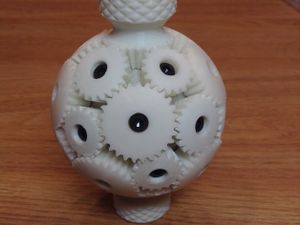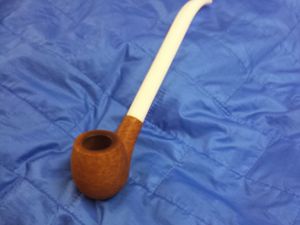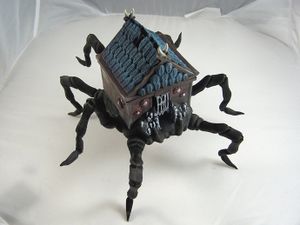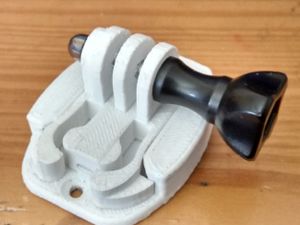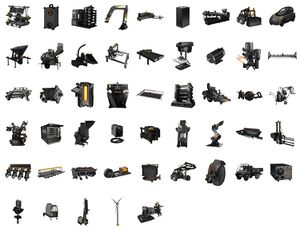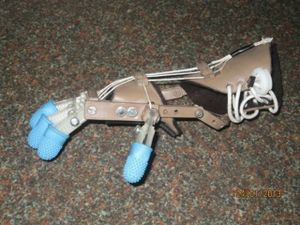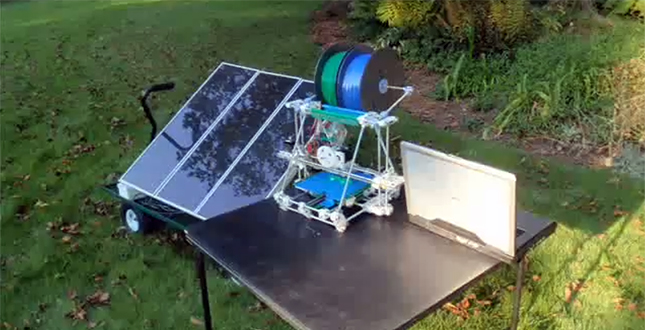User:Chuckdeev/Class Blog
Main | About Me | Class Blog
Enjoy my weekly blogs pertaining to the world of Additive Manufacturing.
Contents
Blog 1: Exploring Thingiverse
Exploring the wide world of Thingiverse and the projected uses of printed items”
A) Something Amazing This gear sphere is incredible on so many levels that it confuses me. How each gear is printed perfectly inside one another while being created on the surface of a sphere is truly fascinating. I would love to see this actually work.
B) Something Funny”"
This Pipe extender is hilarious. When was the last time you were smoking a pipe and said “I wish the bowl was an extra foot farther from my face”? It’s a funny idea and makes you look like a boss when you’re kickin’ back on your porch smoking plants.
C) Something Useless This miniature model is a great representation of how much time people have on their hands and how incredible additive manufacturing really is. The attention to detail for such a useless object is flawless. There is absolutely no use for this in life, anywhere, at any time…
D) Something Useful Stumbling across this GoPro Mount made me realize how useful a personal 3D printer would be. I currently have a GoPro, but lost the mount a year ago and was too lazy to get a new one. Having a printer at your disposal would really change how you go about acquiring any of those small, customizable objects, especially when they are lost.
D) Something Surprising This Rollercoaster car surprised me for different reasons. I understand the capability of these printers and was surprised to see a design for something that would need to have the capability to withstand tons of pressure & weight. I would like to see a full scale print of this that had enough strength to actually work.
Blog 2: Marcin's Open Source Ecology
Exploring the ideas of Marcin Jakubowski.Check out this video to get a general understanding of this man's goal.
Impression and External Information
The world needs more people like Jakubowski. His idea, if completed correctly, could revolutionize the development of our planet's society. Technology is constantly advancing, yet most of it is not available to a majority of people. This is a great way to allow developing or underdeveloped nations to "leapfrog" older, inefficient technologies and skip ahead to better, cleaner, less intensive ways of altering and utilizing their local environments and resources. We run into advanced development issues due to the fact that areas are already developed. Creating this Open Source Ecology manual promotes the cleaner, more advanced technologies that go along with the process we have made as a society. Aside from this project helping undeveloped regions of our world, I can see it being the main focus for building a society on other planets/moons in the future. With all of our technologies these days, we can really make a flawless plan of expanding development if we could start from the beginning.
New Yorker and Marcin Response Articles
Emily Eakin of New Yorker Magazine wrote an article (source) about Marcin's plan of actions, but in reality she bashed and made fun of his way of living and personal tendencies. In a pathetic excuse for journalism, Eakin managed to show us why more people don't have ideas capable of producing major society impacts. She spent four paragraphs explaining what kinds of blue jeans he wears and how his obsessive temperament gets in the way instead of diving into the possibilities this guide book could have on tons of people in the future. Jakubowski wrote up a response (source) in a well mannered way, stating all of the discrepancies between Eakin's analysis and his actual project.
Capabilities at PSU
This type of project could easily spark interest as a think-tank club at Penn State University. There may not be any purpose for completion of designs following the full process that Marcin is carrying out, but what would be interesting and useful is a club that focuses on creating their own basic machines through ideas computer program projections. "Rough draft" versions could be created with the help of our rep rap printers as well. This project could be incorporated into a ton of other clubs, especially those who have service trips to third world countries or work in metal shop. That way we could test out designs on the people who would benefit the most out of this.
Blog 3: RoboHand
Exploring specific uses for additive manufacturing. Check out this story”
Creation of the design
This project was a collaboration between two people across the world from each other. Richard Van As, a South Africa native, lost four of his fingers in an accident, which provided him with some motivation to create this device. After he saw a YouTube video of the mechanics behind making a prosthetic hand, he contacted Ivan Owen of the United States in order to come up with their own robotic hand design for a young boy who was born without a hand.
Where to find it
With the design being open sourced, it is extremely easy to copy the work of Richard Van As & Ivan Owen. Follow this link to the Thingiverse webpage to learn everything you need to carry out the project.
Read more on this
Blog 4: Reviewing Blog 2
I enjoyed reading this blog entry because it was so different from my own. I was so positive about what the project could do in the future that I forgot to analyze the feasibility of it all. Chai does an excellent job of brining those issues to light.
Nam seemed to share the same enthusiasm that I initially had for Marcel's project. He took it a little farther than I did by stating a counter opinion against the project saying that the completion of this could severely hurt the businesses that are known to make these machines.
Kevin did a great job in relating this project to the open source of rep rap printing. Although he brought up a valid argument pertaining to the buyout of this sort of thing, I don't think that would be possible especially because Marcel created this from the ground up and has a strong passion for its possibilities.
I enjoyed reading the paragraph that challenges the use of this project. He says that since Marcel is not proficient in the fields that these machines would be used for, he would not be able to develop them efficiently. I would counter this statement by saying that Marcel is not trying to develop perfect machines, rather simple machines that will JUST get the job done in areas that don't have any machines of these types.
Blog 5: RepRap Media Timeline
Topics receiving continued interested
Thingiverse:
2008 November; Thingiverse is launched;
2011 September 20; Article on the Make blog about a working AR-15 magazine on thingiverse.
2013 January 24; RoboHand is uploaded to Thingiverse.
2013 November 11; Smartrap [201] Summary: Brook Drumm released his design of a reprap based off of the printrbot sample on thingiverse.
Thingiverse is obviously receiving continued interest since it is the first website to ever offer open source codes for rep rap printers. The progression shown in the media timeline is a great way to understand where this has all gone since 2008.
3D printing crime and security
2006 January 12th; 'Printcrime' a short story about RepRap by Cory Doctorow.
2012 July 16; 3D printed keys used to hack high security handcuffs.
2013 April 26; 3D-Printed Guns Can't Be Stopped.
2013 November 7; World's first 3D printed metal gun
3. 3D scanner:
2012 July 17; 3D Printers In The Library; Toward a FabLab in the Academic Library. Summary: The DeLaMare Science & Engineering Library at the University of Nevada, Reno has added two 3D printers, a 3D scanner, and supporting software available for general use to the school community.
2012 November 12; 3D-Printing Photo Booth Makes You Into an Action Figure. Summary: A photo booth in Japan will scan your body and create a figurine of you. It can be a maximum of 8 inches tall and doesn't have the precision yet to pick up on shiny jewelry, earrings, mesh items, or glasses. Customers must pose for about 15 minutes for the machine to collect their body data.
2013 April 26; 3D Scanners Reproduce Real Life.
2013 September 4;All-in-one 3D printer-and-scanners.
2013 December 8; Scientists develop new app to turn mobile phones into 3D scanners
Topics that have slowed/stopped
2012 September 21; 3D Print Wood with Laywood Filament
This is the only post pertaining to this type of printing. I can see why because this does not seem like a good idea at all. Wood isn't man made like the other substances used in printing so this "project" seems a bit useless.
2011 August 25th; Chipotle and Artem use Stratasys Dimension 3D printer for stop motion animation commercial.
This event seems pointless to the progression of 3D printing and is not again mentioned in the timeline.
An influential event
2008 February 9; The Darwin printer is able to print more than half of its own parts, thus self-replication is successful
This is a hugely influential event through the years of 3D printing. To be able to make your own parts really gives this type of printing the opportunity to expand everywhere and anywhere. Self-replication will allow printers to be made in third world countries and provide easy answers to their problems. This probably led to Thingiverse being created as well.
A not so influential event
2010 April 30 'The disruptive future of printing' an article by Bill Thompson of the BBC about RepRap and its future.
By the title of the article, it does not seem that Bill Thompson had anything good to say about the new found world of 3D printing. Obviously, bad media attention will always set back any type of movement.
Something I found interesting"
"(unknown date) Artist uses solar powered 3D printer to make glass objects found here The machine focuses the sun into a dot that is so hot it sinters the sand layer by layer into objects like bowls.
